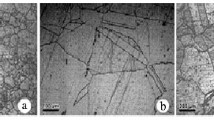Conclusions
The fatigue limit of the titanium carbide and tungsten carbide alloys investigated on a basis of 5·108 cycles lies in the range (20–30)·107 Pa, and is thus comparable with the endurance of type ShKh high-carbon (∼1% C-Mn-Si-Cr) ball-bearing steels. The strength and character of fracture of the hard metals are determined by the properties and structural state of their phase constituents. The highest strength is exhibited by tungsten carbide and titanium carbide alloys with evenly distributed equal-sized carbide grains. The character of fracture of the hard metals varies depending on their method of loading, from brittle in static loading to tough-and-brittle in cyclic loading. On time bases not exceeding 106 cycles titanium carbidehard metals are comparable in fatigue resistance to the standard tungsten-containing hard metals.
Similar content being viewed by others
Literature cited
V. A. Kuz'menko, L. E. Matokhnyuk, G. G. Pisarenko, et al., Fatigue Tests at High Loading Frequencies [in Russian], Naukova Dumka, Kiev (1979).
S. V. Serensen, V. P. Kochaev, and R. M. Shneiderovich, Load-Carrying Capacity and Strength Calculations of Machine Components [in Russian], Mashinostroenie, Moscow (1975).
N. V. Novikov, D. V. Devin, and V. Ch. Levitas, “Analysis of the stressed state of ductile interlayers between rigid grains,” Sverkhtverd. Mater., No. 2, 16–23 (1980).
N. N. Sereda, M. S. Koval'chenko, and O. V. Roman, “Correlation between the structure and behavior of titanium carbide hard metals during cyclic loading,” Transactions of the Seventh International Conference on Powder Metallurgy, Dresden, Vol. 3 (1981), pp. 45–50.
N. N. Sereda, M. S. Koval'chenko, V. A. Tsyban', and L. N. Beloborodov, “Physicomechanical and fatigue properties of titanium carbide base hard metals,” Poroshk. Metall., No. 3, 74–78 (1985).
Y. Fujiwara, H. Ueda, H. Masatomi, and H. Suzuki, “Cyclic strength of WC-12% Co hard metals produced by hot isostatic pressing,” J. Jpn. Soc. Powder Metall.,27, No. 6, 181–184 (1980).
Author information
Authors and Affiliations
Additional information
Translated from Poroshkovaya Metallurgiya, No. 9(273), pp. 67–71, September, 1985.




